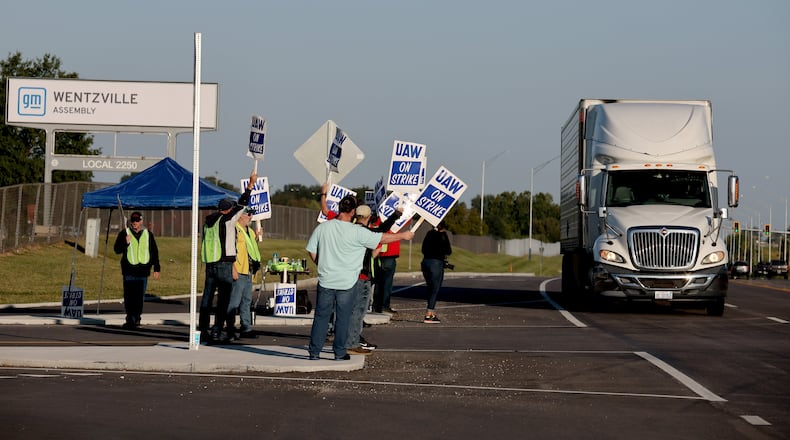The unfolding UAW strike is likely to have little impact on the economy, auto sector, workers or consumers in Georgia. At least at first.
Car buyers will have no shortage of vehicles to choose from, none of the assembly lines being struck are here and any damage from lost wages, lost sales and production disruptions will hit far-off regional economies.
But non-union companies can be affected by changes in pay and benefits to competitors, and an extended strike could have both symbolic and real consequences, said economist Mark Vitner, chief economist at Piedmont Crescent Capital.
“The UAW strike is a major test for the labor market for the auto industry and manufacturing in general,” he said. “I worry that the automakers will cave in to an agreement that they cannot afford, particularly with the economy looking like it will struggle a bit over the next few quarters.”
While the unionized auto sector isn’t the national powerhouse it used to be, it is still a significant force in the economy and a crucial target for organized labor’s efforts to pump up worker pay and benefits. And in Georgia, auto’s importance has been accelerating.
In a state where few people have access to or use public transit, the appetite for vehicles is robust. Georgia has nearly 500 local franchise dealerships where roughly 35,000 people work, according to the Georgia Automotive Dealers Association.
Nearly 82,000 Georgians work in auto and auto-related companies, according to the state Department of Economic Development. Of that group, almost 30,000 work in auto and auto-parts manufacturing; just over 52,000 work in auto repair, maintenance, and other services.
A prolonged strike would mean less production of parts, which could make for shortages and push prices up for both used and new cars.
The sector overall has grown in importance, with production of vehicles and parts surging in recent years, partly fueled by generous incentives from federal, state and local governments, and it is on track for still more dramatic growth.
Vehicles and parts manufacturing contributed $3.8 billion to Georgia’s economy in 2021 and is punching above its weight, said Jackie Benson, economist for Wells Fargo.
“Although that’s less than 1% of (the economy), it’s a pretty sizable jump from prior years,” she said. “Adjusted for inflation, output from motor vehicle and parts manufacturing jumped 36% from 2020 to 2021.”
The number of workers in production of vehicles and parts manufacturing was up 4.9% from March 2022 to March 2023, while total payrolls rose 3.0% in that period, she said.
But virtually all of auto’s presence in Georgia is thus far non-union.
A generation ago, that wasn’t the case. For more than a half-century, thousands of UAW workers churned out Fords at a plant in Hapeville and General Motors vehicles at a factory in Doraville. Ford closed in 2006; GM’s plant two years later.
Not long after, Kia opened a huge production facility in West Point. A flurry of other plants, mainly for electric vehicles and their parts, are in the works. But like virtually all the other vehicle manufacturing plants now sprinkled through the South, all are currently non-union.
Which is the same lane as the larger economy: Just 5.4% of Georgia’s workforce is represented by unions, compared to 11.3% nationally. Georgia labor laws also discourage organizing, meaning the union push faces long odds in succeeding.
But the nation and Georgia have seen an increase in organizing activity, and the Teamsters recently reached a landmark 5-year deal for its 340,000 organized workers at Sandy Springs-based UPS.
That pact spurred talk about knock-on effects at non-union competitors like FedEx. So union advocates hope — and fearful businesses fear — that UAW success could have the same kind of influence.
Yet both carmakers and the union have an incentive to exaggerate the economic impact of a strike to appeal for support, economist Justin Wolfers told CNN. “The reality is that this is not a manufacturing economy that we live in.”
In the years after World War II, nearly one-third of workers were in manufacturing. The sector now accounts for less than 10%, nationally and in Georgia.
And whatever the unforeseeable consequences of a long and bitter strike, the immediate impact will be minimal.
— The roughly 146,000 workers whose contract has expired and are represented by the United Auto Workers, work for General Motors, Ford and Stellantis in plants elsewhere, mostly in the North.
— Inventories — that is, the number of cars that dealers have available to sell — are ample for most makes, according to Michelle Krebs, an analyst for Cox Automotive, which is owned by the same company that owns the Atlanta Journal-Constitution.
Chrysler has the most vehicles stockpiled for sale: 119 days’ worth, with Dodge and Ram not far behind, she said. All are owned by Stellantis.
Ford and GM are both above the national average of 58 days, according to Krebs.
About the Author
The Latest
Featured



